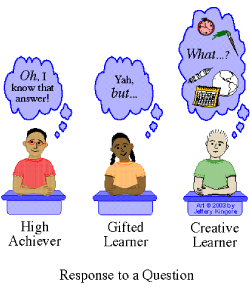ARTICLES FOR EDUCATORS & PARENTS
High Achiever, Gifted Learner, Creative Thinker
Kingore, B. (2004). Differentiation: Simplified, realistic, and effective. Austin: P. A. Publishing.
Identification of gifted students is clouded when concerned adults misinterpret high achievement as giftedness. High-achieving students are noticed for their on-time, neat, well-developed, and correct learning products. Adults comment on these students’ consistent high grades and note how well they acclimate to class procedures and discussions. Some adults assume these students are gifted because their school-appropriate behaviors and products surface above the typical responses of grade-level students.
Educators with expertise in gifted education are frustrated trying to help other educators and parents understand that while high achievers are valuable participants whose high-level modeling is welcomed in classes, they learn differently from gifted learners. In situations in which they are respected and encouraged, gifted students’ thinking is more complex with abstract inferences and more diverse perceptions than is typical of high achievers. Articulating those differences to educators and parents can be difficult.
In 1989, Janice Szabos published a comparison of the bright child and the gifted learner. Her comparison helps to delineate differences between the two groups and provides a useful format for discussions. However, some of the items listed in the comparison are questionable. For example, the gifted learner is credited with having wild, silly ideas. In reality, it is creative thinkers who exhibit the ideas often called wild or silly; not all gifted learners demonstrate that aspect of the creative process. As a second example of concern, Szabos lists bright children as enjoying straightforward, sequential presentations. This behavior seems more associated with learning preferences than with ability. Arguably, some gifted learners also enjoy straightforward, sequential presentations, but their questions and responses to such a presentation may dramatically differ from the questions and responses of bright children. As a final example, Szabos’ comparison states that gifted learners prefer adults while bright children enjoy peers. This statement has negative connotations leading to the stereotype that gifted learners are so out of sync with society and have such poor social skills that they can only communicate with adults. In reality, gifted learners seek idea-mates rather than age-mates. They enjoy the company of peers when the peer group understands the shared ideas.
Responding to those concerns, a three-way comparison of a high achiever, a gifted learner, and a creative thinker is proposed for you to consider and ponder. No column is intended to be mutually exclusive. For example, a high achiever might also be a creative thinker, and a gifted learner might also be a creative thinker; a creative thinker might also be a high achiever, and a gifted learner might also be a high achiever. This three-column comparison emerged over several years while working with students representing all three of these groups. Hundreds of teachers and students reviewed and discussed the items as the comparison developed.
These students and teachers found the following cartoons helpful in understanding the comparison since high achievers, gifted learners, and creative thinkers co-exist in many classrooms. In the first cartoon, the teacher announces an assignment, and the high achiever quickly tries to determine what the teacher most wants so he can please and satisfy the teacher’s intentions: “What do you really want?” The gifted learner ponders what to do that would most interest her as she learns: “What I would like to do is…” Simultaneously, the creative thinker’s mind begins to race with all of the diverse and varied possibilities that could be explored:

Later, in the second cartoon, the teacher poses a question to the class. The high achiever is delighted because he knows the answer and is in control: “Oh, I know that answer!” The gifted learner considers multiple nuances and alternative perspectives: “The question could mean…” or “It might suggest…” or “Another way to say that is…” or “Yah, but…” The creative thinker is still obsessed with the seemingly endless possibilities of the earlier assignment, concentrating so much on his ideas that he completely misses the teacher’s question:

Consider sharing this three-way comparison with your gifted students to elicit their perceptions. If you wish, their responses can be shared with the author at the email listed below. Stimulating discussion rather than fostering agreement is the goal. The results might clarify or extend understanding among administrators, teachers, parents, and students of the marvelous similarities and differences among high achievers, gifted learners, and creative thinkers.
Gifted learners prefer idea-mates rather than age-mates. They enjoy the company of peers when the peer group understands the shared ideas.

References
Szabos, J. (1989). Bright child, gifted learner. Challenge, 34. Good Apple.
